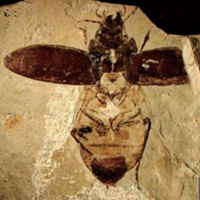An outlook on the evolutionary history of Carabid beetles (Coleoptera, adephaga)

All claims expressed in this article are solely those of the authors and do not necessarily represent those of their affiliated organizations, or those of the publisher, the editors and the reviewers. Any product that may be evaluated in this article or claim that may be made by its manufacturer is not guaranteed or endorsed by the publisher.
The paper is an attempt to take stock of recent research on the evolutionary history of the megadiverse beetle family Carabidae. First, the evolution of the carabid body is presented in its fundamental characteristics, in relation to the thoracic structure and locomotory and morphofunctional constraints, taking into account also what we know about fossil findings. Changes are described in the ten fundamental life forms that are recognizable in the larval body, from primitive surface runner to the arboreal tree/bark dweller and the parasitoid life style. The influence of biotic factors, first of all the food preferences, are examined for the best-known subfamilies/tribes, and a synthetic frame is presented of relationships between prey and age of the lineages in the three types of feeding modes: fluid, fragment and mixed feeders. On the whole, Harpalinae lineages seem more adapted to preys that appeared in recent times after the angiosperm flourishing, though exceptions have found. The availability of the biomasses of social insect nests, ants and termites, was of fundamental importance for several carabid stems. The influence of predators surely contributed to the refinement of chemical defenses, and some avoidance behaviours as gregariousness and müllerian mimcry. Ordering the relevant fossil findings by age and taxon the absence of modern carabid fossils in the first part of mesozoic appears clearly, only in the Cretaceous some extinct forms belonging to the actual suprageneric taxa have been found. Thus, Cenozoic era should be retained the age of modern forms, even if extinct taxa are recorded at least until the late miocene. Concerning the old question of ancestral habitat of adephaga, if terrestrial or aquatic, the intermediate hypothesis of Erwin seems still valid, that is a waterside life on shores rich of animal biomass, from which both directions into inland waters and subaerial ecosystems may have started. Finally, the taxonomic position of Rhysodidae has examined in the light of recent studies. morphology of adult and larval beetles is poorly in accordance with a place in Scaritinae (Clivinini), the preimaginal features remember that of archostemata also in the probable presence of a fused labrum, molecular evidence is mainly indicating a position within Carabidae but still not conclusive. a place as separate family within basal Geadephaga should be maintained.
Gli autori che pubblicano su questa rivista accettano le seguenti condizioni:
- gli autori mantengono i diritti sulla loro opera e cedono alla rivista il diritto di prima pubblicazione dell'opera, licenziata sotto una Creative Commons Attribution NonCommercial 4.0 International License (CC BY-NC 4.0) che permette ad altri di condividere l'opera indicando la paternità intellettuale e la prima pubblicazione su questa rivista.
- gli autori possono aderire ad altri accordi di licenza non esclusiva per la distribuzione della versione dell'opera pubblicata (es. depositarla in un archivio istituzionale o pubblicarla in una monografia), a patto di indicare che la prima pubblicazione è avvenuta su questa rivista.
- Gli autori possono diffondere la loro opera online (es. in repository istituzionali o nel loro sito web) prima e durante il processo di submission, poichè può portare a scambi produttivi e aumentare le citazioni dell'opera pubblicata (Vedi The Effect of Open Access).


 https://doi.org/10.4081/memoriesei.2020.15
https://doi.org/10.4081/memoriesei.2020.15



